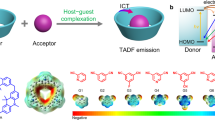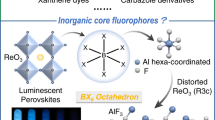Abstract
Silver(i) chalcogenide/chalcogenolate clusters are promising photofunctional materials for sensing, optoelectronics and solar energy harvesting applications. However, their instability and poor room-temperature luminescent quantum yields have hampered more extensive study. Here, we graft such clusters to adaptable bridging ligands, enabling their interconnection and the formation of rigid metal–organic frameworks. By controlling the spatial separation and orientation of the clusters, they then exhibit enhanced stability (over one year) and quantum yield (12.1%). Ultrafast dual-function fluorescence switching (<1 s) is also achieved, with turn-off triggered by O2 and multicoloured turn-on by volatile organic compounds. Single-crystal X-ray diffraction of the inclusion materials, obtained by single-crystal-to-single-crystal transformation, enables precise determination of the position of the small molecules within the framework, elucidating the switching mechanism. The work enriches the cluster-based metal–organic framework portfolio, bridges the gap between silver chalcogenide/chalcogenolate clusters and metal–organic frameworks, and provides a foundation for further development of functional silver-cluster-based materials.
This is a preview of subscription content, access via your institution
Access options
Access Nature and 54 other Nature Portfolio journals
Get Nature+, our best-value online-access subscription
$29.99 / 30 days
cancel any time
Subscribe to this journal
Receive 12 print issues and online access
$259.00 per year
only $21.58 per issue
Buy this article
- Purchase on Springer Link
- Instant access to full article PDF
Prices may be subject to local taxes which are calculated during checkout




Similar content being viewed by others
References
Desireddy, A. et al. Ultrastable silver nanoparticles. Nature 501, 399–402 (2013).
Yang, H. et al. All-thiol-stabilized Ag44 and Au12Ag32 nanoparticles with single-crystal structures. Nat. Commun. 4, 2422 (2013).
Schmidbaur, H. & Schier, A. Argentophilic interactions. Angew. Chem. Int. Ed. 54, 746–784 (2015).
Wang, Q.-M., Lin, Y.-M. & Liu, K.-G. Role of anions associated with the formation and properties of silver clusters. Acc. Chem. Res. 48, 1570–1579 (2015).
Joshi, C. P., Bootharaju, M. S. & Bakr, O. M. Tuning properties in silver clusters. J. Phys. Chem. Lett. 6, 3023–3035 (2015).
Fuhr, O., Dehnen, S. & Fenske, D. Chalcogenide clusters of copper and silver from silylated chalcogenide sources. Chem. Soc. Rev. 42, 1871–1906 (2013).
Yam, V. W.-W., Au, V. K.-M. & Leung, S. Y.-L. Light-emitting self-assembled materials based on d8 and d10 transition metal complexes. Chem. Rev. 115, 7589–7728 (2015).
Goswami, N. et al. Luminescent metal nanoclusters with aggregation-induced emission. J. Phys. Chem. Lett. 7, 962–975 (2016).
Li, G., Lei, Z. & Wang, Q.-M. Luminescent molecular Ag−S nanocluster [Ag62S13(SBut)32](BF4)4 . J. Am. Chem. Soc. 132, 17678–17679 (2010).
Chen, Y. et al. Isomerism in Au28(SR)20 nanocluster and stable structures. J. Am. Chem. Soc. 138, 1482–1485 (2016).
AbdulHalim, L. G. et al. Ag29(BDT)12(TPP)4: a tetravalent nanocluster. J. Am. Chem. Soc. 137, 11970–11975 (2015).
Liu, W. et al. A family of highly efficient CuI-based lighting phosphors prepared by a systematic, bottom-up synthetic approach. J. Am. Chem. Soc. 137, 9400–9408 (2015).
Furukawa, H., Cordova, K. E., O'Keeffe, M. & Yaghi, O. M. The chemistry and applications of metal–organic frameworks. Science 341, 1230444 (2013).
Distefano, G. et al. Highly ordered alignment of a vinyl polymer by host–guest cross-polymerization. Nat. Chem. 5, 335–341 (2013).
Cui, Y., Yue, Y., Qian, G. & Chen, B. Luminescent functional metal–organic frameworks. Chem. Rev. 112, 1126–1162 (2012).
Lin, R.-B. et al. A noble-metal-free porous coordination framework with exceptional sensing efficiency for oxygen. Angew. Chem. Int. Ed. 52, 13429–13433 (2013).
Li, J.-R., Sculley, J. & Zhou, H.-C. Metal organic frameworks for separations. Chem. Rev. 112, 869–932 (2012).
Devic, T. & Serre, C. High valence 3p and transition metal based MOFs. Chem. Soc. Rev. 43, 6097–6115 (2014).
Howarth, A. J. et al. Chemical, thermal and mechanical stabilities of metal–organic frameworks. Nat. Rev. Mater. 1, 15018 (2016).
Zhang, W.-X. et al. Metal cluster-based functional porous coordination polymers. Coord. Chem. Rev. 293–294, 263–278 (2015).
Han, Q. et al. Polyoxometalate-based homochiral metal–organic frameworks for tandem asymmetric transformation of cyclic carbonates from olefins. Nat. Commun. 6, 10007 (2015).
Perry, J. J. IV, Perman, J. A. & Zaworotko, M. J. Design and synthesis of metal–organic frameworks using metal–organic polyhedra as supermolecular building blocks. Chem. Soc. Rev. 38, 1400–1417 (2009).
Slater, A. G. & Cooper, A. I. Porous materials. function-led design of new porous materials. Science 348, aaa8075 (2015).
Cui, Y. et al. Metal–organic frameworks as platforms for functional materials. Acc. Chem. Res. 49, 483–493 (2016).
Yaghi, O. M. et al. Reticular synthesis and the design of new materials. Nature 423, 705–714 (2003).
Guillerm, V. et al. Discovery and introduction of a (3,18)-connected net as an ideal blueprint for the design of metal–organic frameworks. Nat. Chem. 6, 673–680 (2014).
Schoedel, A. et al. The asc trinodal platform: two-step assembly of triangular, tetrahedral, and trigonal-prismatic molecular building blocks. Angew. Chem. Int. Ed. 52, 2902–2905 (2013).
Lei, Z., Pei, X.-L., Jiang, Z.-G. & Wang, Q.-M. Cluster linker approach: preparation of a luminescent porous framework with NbO topology by linking silver ions with gold(i) clusters. Angew. Chem. Int. Ed. 53, 12771–12775 (2014).
Fowler, D. A. et al. Coordination polymer chains of dimeric pyrogallol[4]arene capsules. J. Am. Chem. Soc. 133, 11069–11071 (2011).
Wei, Z. et al. Rigidifying fluorescent linkers by metal–organic framework formation for fluorescence blue shift and quantum yield enhancement. J. Am. Chem. Soc. 136, 8269–8276 (2014).
Gong, Q. et al. Solution processable MOF yellow phosphor with exceptionally high quantum efficiency. J. Am. Chem. Soc. 136, 16724–16727 (2014).
Kreno, L. E. et al. Metal–organic framework materials as chemical sensors. Chem. Rev. 112, 1105–1125 (2012).
Hu, Z., Deibert, B. J. & Li, J. Luminescent metal–organic frameworks for chemical sensing and explosive detection. Chem. Soc. Rev. 43, 5815–5840 (2014).
Takashima, Y. et al. Molecular decoding using luminescence from an entangled porous framework. Nat. Commun. 2, 168 (2011).
de Silva, A. P. & Uchiyama, S. Molecular logic and computing. Nat. Nanotech. 2, 399–410 (2007).
Xie, Z., Ma, L., deKrafft, K. E., Jin, A. & Lin, W. Porous phosphorescent coordination polymers for oxygen sensing. J. Am. Chem. Soc. 132, 922–923 (2010).
Wang, X.-D. & Wolfbeis, O. S. Optical methods for sensing and imaging oxygen: materials, spectroscopies and applications. Chem. Soc. Rev. 43, 3666–3761 (2014).
Lehner, P., Staudinger, C., Borisov, S. M. & Klimant, I. Ultra-sensitive optical oxygen sensors for characterization of nearly anoxic systems. Nat. Commun. 5, 4460 (2014).
Inokuma, Y., Kawano, M. & Fujita, M. Crystalline molecular flasks. Nat. Chem. 3, 349–358 (2011).
Liao, P.-Q., Zhu, A.-X., Zhang, W.-X., Zhang, J.-P. & Chen, X.-M. Self-catalysed aerobic oxidization of organic linker in porous crystal for on-demand regulation of sorption behaviours. Nat. Commun. 6, 6350 (2015).
Zhang, J.-P., Liao, P.-Q., Zhou, H.-L., Lin, R.-B. & Chen, X.-M. Single-crystal X-ray diffraction studies on structural transformations of porous coordination polymers. Chem. Soc. Rev. 43, 5789–5814 (2014).
Ikemoto, K., Inokuma, Y., Rissanen, K. & Fujita, M. X-ray snapshot observation of palladium-mediated aromatic bromination in a porous complex. J. Am. Chem. Soc. 136, 6892–6895 (2014).
Bloch, W. M. et al. Capturing snapshots of post-synthetic metallation chemistry in metal–organic frameworks. Nat. Chem. 6, 906–912 (2014).
Kitaura, R. et al. Formation of a one-dimensional array of oxygen in a microporous metal–organic solid. Science 298, 2358–2361 (2002).
Murray, L. J. et al. Highly-selective and reversible O2 binding in Cr3(1,3,5-benzenetricarboxylate)2 . J. Am. Chem. Soc. 132, 7856–7857 (2010).
Carrington, E. J., Vitorica-Yrezabal, I. J. & Brammer, L. Crystallographic studies of gas sorption in metal–organic frameworks. Acta Crystallogr. B 70, 404–422 (2014).
Reichardt, C. Solvatochromic dyes as solvent polarity indicators. Chem. Rev. 94, 2319–2358 (1994).
Wang, L., Li, B., Zhang, L., Li, P. & Jiang, H. An optical anion chemosensor based on a europium complex and its molecular logic behavior. Dyes Pigments 97, 26–31 (2013).
Vitórica-Yrezábal, I. J. et al. Chemical transformations of a crystalline coordination polymer: a multi-stage solid–vapour reaction manifold. Chem. Sci. 4, 696–708 (2013).
Chen, P. & Meyer, T. J. Medium effects on charge transfer in metal complexes. Chem. Rev. 98, 1439–1478 (1998).
Acknowledgements
This work was supported by the National Natural Science Foundation of China (grants nos 21671175, 21371153 and 21371154), the Program for Science & Technology Innovation Talents in Universities of Henan Province (no. 164100510005) and Zhengzhou University. The authors thank Y.-Y. Zhu and D.-H. Wei for discussions on DFT calculations. The authors also thank J.-P. Zhang (Sun Yat-Sen University, Guangzhou, China) for discussions and help, and F. Pan (Central China Normal University, Wuhan, China) for his direction and help with crystallographic resolution.
Author information
Authors and Affiliations
Contributions
S.-Q.Z. conceived and designed the experiments. R.-W.H. and Y.-S.W. conducted the synthesis. R.-W.H. and X.-H.W. performed SCXRD measurements and crystal structure analyses. R.-W.H., X.-H.W., X.-Y.D., C.-X.D. and S.-Q.Z. performed physical measurements. S.-Q.Z., R.-W.H. and T.C.W.M. co-wrote the manuscript.
Corresponding author
Ethics declarations
Competing interests
The authors declare no competing financial interests.
Supplementary information
Supplementary information
Supplementary information (PDF 13263 kb)
Supplementary information
Supplementary Movie 1 (MP4 945 kb)
Supplementary information
Supplementary Movie 2 (MP4 440 kb)
Supplementary information
Supplementary Movie 3 (MP4 659 kb)
Supplementary information
Supplementary Movie 4 (MP4 466 kb)
Supplementary information
Crystallographic data for compound Ag12 (CIF 2082 kb)
Supplementary information
Crystallographic data for compound Ag12bpy-290K (CIF 290 kb)
Supplementary information
Crystallographic data for compound Ag12bpy-100K (CIF 253 kb)
Supplementary information
Crystallographic data for compound Ag12bpy·O2-290K (CIF 291 kb)
Supplementary information
Crystallographic data for compound Ag12bpy·O2-100K (CIF 256 kb)
Supplementary information
Crystallographic data for compound Ag12bpy·EtOH (CIF 333 kb)
Supplementary information
Crystallographic data for compound Ag12bpy·Chloroform (CIF 244 kb)
Supplementary information
Crystallographic data for compound Ag12bpy·Acetonitrile (CIF 894 kb)
Supplementary information
Crystallographic data for compound Ag12bpy·Acetone (CIF 1014 kb)
Supplementary information
Crystallographic data for compound Ag12bpy·Cyclohexane (CIF 273 kb)
Supplementary information
Crystallographic data for compound Ag12bpy·Dioxane (CIF 1180 kb)
Supplementary information
Crystallographic data for compound Ag12bpy·Benzene (CIF 942 kb)
Supplementary information
Crystallographic data for compound Ag12bpy·Toluene (CIF 1148 kb)
Supplementary information
Crystallographic data for compound Ag12bpy·Fluorobenzene (CIF 2425 kb)
Supplementary information
Crystallographic data for compound Ag12bpy·Chlorobenzene (CIF 1024 kb)
Supplementary information
Crystallographic data for compound Ag12bpy·Bromobenzene (CIF 294 kb)
Supplementary information
Crystallographic data for compound Ag12bpy·Iodobenzene (CIF 533 kb)
Supplementary information
Crystallographic data for compound Ag12bpy· o -Xylene (CIF 558 kb)
Supplementary information
Crystallographic data for compound Ag12bpy· m -Xylene (CIF 797 kb)
Supplementary information
Crystallographic data for compound Ag12bpy· p -Xylene (CIF 993 kb)
Rights and permissions
About this article
Cite this article
Huang, RW., Wei, YS., Dong, XY. et al. Hypersensitive dual-function luminescence switching of a silver-chalcogenolate cluster-based metal–organic framework. Nature Chem 9, 689–697 (2017). https://doi.org/10.1038/nchem.2718
Received:
Accepted:
Published:
Issue Date:
DOI: https://doi.org/10.1038/nchem.2718
This article is cited by
-
Atomically precise photothermal nanomachines
Nature Materials (2024)
-
A fast responsive photochromic SCC-MOF for photoswitching and information encryption
Science China Materials (2024)
-
Multi-stimuli-responsive aggregation-induced emission copper iodide cluster
Science China Chemistry (2024)
-
Application of gold nanoclusters in fluorescence sensing and biological detection
Analytical and Bioanalytical Chemistry (2024)
-
Silver nanoparticle enhanced metal-organic matrix with interface-engineering for efficient photocatalytic hydrogen evolution
Nature Communications (2023)



